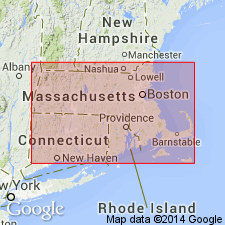
- Usage in publication:
-
- Quincy granite
- Modifications:
-
- First used
- Dominant lithology:
-
- Granite
- AAPG geologic province:
-
- New England province
Summary:
First used Quincy granite for granite exposed in quarries near the town of Quincy, Essex Co., MA. The granite is coarsely crystalline feldspathic granite composed of orthoclase, quartz, and hornblende with orthoclase the predominant mineral.
Source: GNU records (USGS DDS-6; Reston GNULEX).
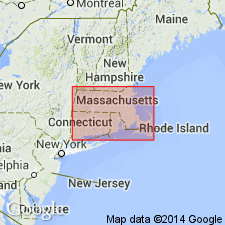
- Usage in publication:
-
- Quincy Granite*
- Modifications:
-
- [Principal reference]
- Dominant lithology:
-
- Granite
- AAPG geologic province:
-
- New England province
Summary:
Pg. 167, 188-196, and map. The normal Quincy granite is a moderately coarse-grained rock composed of dominant quartz, feldspar, and hornblende with accesory aegirite, zircon, titanite, and ores. Age is considered Carboniferous, based on cross-cutting relationships.
Type area: in Quincy and Milton, eastern MA, but largest area is in eastern Essex Co., eastern MA.
Source: US geologic names lexicon (USGS Bull. 896, p. 1759), supplemental information from GNU records (USGS DDS-6; Reston GNULEX).
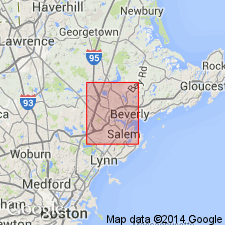
- Usage in publication:
-
- Quincy Granite*
- Modifications:
-
- Revised
- Age modified
- AAPG geologic province:
-
- New England province
Summary:
Revised the Quincy Granite to retain use in Quincy area, but renamed granites of other areas in Essex Co., MA as the Peabody and Cape Ann Granites. This revision is based on petrographic differences in the granites. Although not firm, the age of the Quincy Granite is believed to be 260-270 Ma or Early Permian.
Source: GNU records (USGS DDS-6; Reston GNULEX).
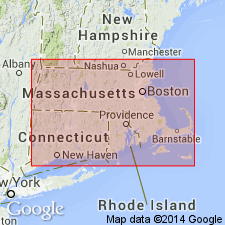
- Usage in publication:
-
- Quincy Granite*
- Modifications:
-
- Age modified
- Geochronologic dating
- AAPG geologic province:
-
- New England province
Summary:
Isotopic dating using zircons produced a Late Ordovician or Early Silurian age for the Quincy Granite.
Source: GNU records (USGS DDS-6; Reston GNULEX).

- Usage in publication:
-
- Quincy Granite*
- Modifications:
-
- Overview
- AAPG geologic province:
-
- New England province
Summary:
Used as Quincy Granite of Late Ordovician or Early Silurian age. Consists of alkalic granite containing riebeckite and aegerine. Intrudes Braintree Argillite and Weymouth Formation (undivided) and possibly Cambridge Argillite.
Source: GNU records (USGS DDS-6; Reston GNULEX).
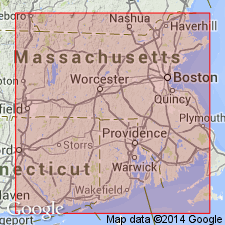
- Usage in publication:
-
- Rhode Island Quincy Granite
- Modifications:
-
- Revised
- Age modified
- Overview
- AAPG geologic province:
-
- New England province
Summary:
Author refers to the Quincy Granite, mapped in RI by Quinn (1971), as the Rhode Island Quincy Granite, or alternately, the Quincy Granite of Rhode Island, to differentiate it from the Quincy Granite of MA. The two granites were thought by Quinn to be the same unit based on similar mineral assemblages, but they have since been shown to be of entirely different ages by Hermes and Zartman (1985) who dated both rocks. The Quincy at its type locality is Ordovician (440+/-17 Ma), while the Quincy in RI is Mississippian (344 Ma). Hermes and Zartman suggested that the RI unit be referred to as the Quincy Granite (of Quinn, 1971) until it is renamed. The Rhode Island Quincy is here assigned to the Scituate Plutonic Supersuite along with the Scituate Granite and the East Greenwich Plutonic Suite, which includes the Cowesett Granite and the Spencer Hill Volcanics.
[There is an apparent discrepancy in this grouping. The Scituate Plutonic Supersuite is defined as including all recognized Devonian plutons and volcanic units of alkaline affinity in Rhode Island. The Quincy, however, is Mississippian. Usage here is not recommended.]
Source: GNU records (USGS DDS-6; Reston GNULEX).
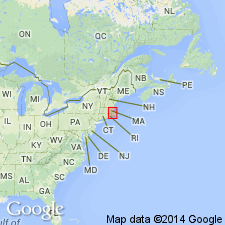
- Usage in publication:
-
- Quincy Granite*
- Modifications:
-
- Overview
- Areal extent
- Age modified
- AAPG geologic province:
-
- New England province
Summary:
Quincy Granite intrudes Middle Cambrian Braintree Argillite. Southern contact is with chemically and mineralogically similar Blue Hills Granite Porphyry. Fresh rock is dark gray to dark green, weathering to buff brown or salmon. Bounded on the northwest by Blue Hills thrust and on the west by Neponset fault. No clasts of Quincy observed in Early Pennsylvanian Pondville Conglomerate, but clasts of overlying and probably related Blue Hills Granite Porphyry are common in Pondville. Combined area of Quincy and Blue Hills rocks is 55 sq km. Small mass of "Quincy Granite" east of Woonsocket, RI, near RI-MA border is similar in texture to Quincy Granite at Quincy, MA, but is more peralkaline. The mass near Woonsocket was thought at the time of compilation of the MA State geologic map (Zen and others, 1983) to be same general age as granite at Quincy. Age of mass at Woonsocket has been more recently determined to be Devonian or possibly Carboniferous, rather than Late Ordovician and Silurian (Hermes and Zartman (1985). [Papers presented as chapters in U.S. Geological Survey Professional Paper 1366 are intended as explanations and (or) revisions to MA State bedrock geologic map of Zen and others (1983) at scale of 1:250,000.]
Source: GNU records (USGS DDS-6; Reston GNULEX).
For more information, please contact Nancy Stamm, Geologic Names Committee Secretary.
Asterisk (*) indicates published by U.S. Geological Survey authors.
"No current usage" (†) implies that a name has been abandoned or has fallen into disuse. Former usage and, if known, replacement name given in parentheses ( ).
Slash (/) indicates name conflicts with nomenclatural guidelines (CSN, 1933; ACSN, 1961, 1970; NACSN, 1983, 2005, 2021). May be explained within brackets ([ ]).

